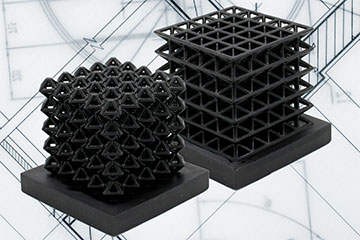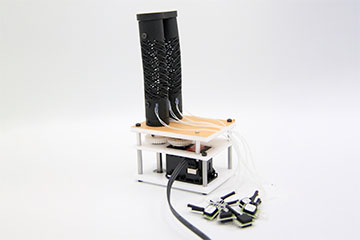
3D-printed crystalline lattice structures with air-filled channels, known as "fluidic sensors.” [Image: Courtesy of the researchers, edited by MIT News]
Digital light processing, or DLP—the light-directing micromirror technology inside conference room projectors and neighborhood cinemas—has another practical use: curing photopolymer resin inside 3D printers. Researchers at the Massachusetts Institute of Technology (MIT), USA, have tweaked the DLP-enabled printing process to build single-material structures with embedded sensors (Sci. Adv., doi: 10.1126/sciadv.abq4385).
After using the DLP-based printer to create networks of tiny air-filled channels, the researchers could measure pressure changes within the channels to monitor mechanical movements of the printed materials. The technology might be harnessed for future wearable smart devices and flexible robots.
DLP 3D printing
At the heart of all DLP devices, whether they project light or print with it, is a digital micromirror—a micro-electromechanical system (MEMS) array of tiny mirrors that divide a beam of light into pixels. In a 3D printer, the pixels of UV light are reflected off the mirrors and projected onto a liquid photosensitive resin to cure it. The process is similar to another 3D printing method called stereolithography. But, while stereolithography relies on a single narrow laser beam that traces out the prescribed design on the polymer resin pixel by pixel, DLP printing can harden an array of resin pixels all at once, making 3D printing faster.
The MIT team designed several types of lattice structures, both cubic and octahedral, with modeling software. On the macroscopic scale, the lattice designs may look simple, but the various branches of the lattice incorporate narrow interior channels.
A soft robotic finger made from two cylinders that consist of a new class of materials, which bend and rotate. Air-filled channels embedded within the structure connect to pressure sensors (pile of chips in the foreground), which actively measure the pressure change of these “fluidic sensors.” [Image: Courtesy of the researchers; MIT] [Enlarge image]
Next, the researchers printed the forms with a commercially available DLP printer and elastomeric polyurethane. Non-polymerized resin that did not harden in the printer’s UV light was trapped in the channels during the printing process, but the research team later cleared that resin by vacuuming and flushing the channels with pressurized air and isopropanol.
These remaining air-filled chambers—or “fluidic sensors,” as the team dubbed them—were connected with tubes to pressure sensors. As the researchers bent, squeezed and rotated the 3D-printed lattices, the sensors picked up the changes in air pressure within the lattices. With some calibration, the team could detect through the fluidic-sensing system whether the lattices were elongated, contracted or twisted.
Advancing exiting technology
The MIT group’s printed lattices belong to a class of materials called “architected materials,” fabricated with sparse, complex geometries. DLP 3D-printing methods are already used to make many of these architected designs, but attaching sensors to these complicated surfaces was difficult before the new approach demonstrated by the MIT researchers. They hope their technique will lead to new types of autonomous robots and wearable devices.

